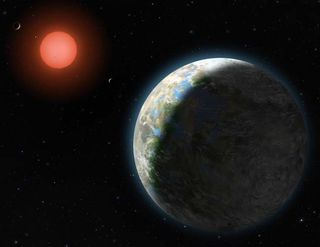Claim of Alien Signal from Planet Gliese 581g Called ‘Very Suspicious’

The recent discovery of Gliese 581g, an alien planet in thehabitable zone of another star, has been an exciting development for scientistsprobing the galaxy for signs of extraterrestrial life. At least one claim of apossible signal from the planet has already surfaced ? and been met with harshskepticism among the science community.
Following the Sept. 29 announcement of the discoveryof Gliese 581g, astronomer Ragbir Bhathal, a scientist at the University ofWestern Sydney, claimed to have detected a suspicious pulse of light nearly twoyears ago, that came from the same area of the galaxy as the location of Gliese581g, according to the U.K.'s Daily Mail online. [AlienPlanet Gliese581g: FAQ]
Bhathal is a member of the Australian chapter of SETI, a non-profitscientific organization that is dedicated to research, exploration andeducation in the fieldof astrobiology.
"Whenever there's a clear night, I go up to theobservatory and do a run on some of the celestial objects," Bhathal toldthe Daily Mail. "Looking at one of these objects, we found this signal. Wefound this very sharp signal, sort of a laser lookalike thing which is the sortof thing we're looking for ? a very sharp spike. And that is what wefound."
Still, there are some scientists who are skeptical ofBhathal's assertion.
"I know the scientist, and when he first announced it,I asked him for the details, and he wouldn't send them to me," astronomer andSETIpioneer Frank Drake told SPACE.com. "I'm very suspicious."
Drake is credited with conducting the first search forsignals from extraterrestrial intelligences 50 years ago as part of what wasthen called Project Ozma. He coined the famed Drake Equation to calculate thenumber (N) of alien civilizations with whom we might be able to communicate
Get the Space.com Newsletter
Breaking space news, the latest updates on rocket launches, skywatching events and more!
Further study would perhaps confirm or deny the supposedobservation, but Drake thinks that the claim is likely a dubious one.
Strange signal, or phantom?
Bhathal claimed to have detected the puzzling signal in Dec.2008, almost two years before researchers announced the Gliese 581g finding,and long before it was announced that habitable planets were found orbiting thestar Gliese 581 itself.
"I'm not aware of the location that was claimed for thesource of that light, and [Bhathal] refused to tell me where it camefrom," Drake said. "I think it's very unlikely that it came from thedirection of Gliese 581."
Gliese 581g is one of two new worlds that was discoveredorbiting the red dwarf star Gliese 581, which is located about 20.5 light-yearsfrom Earth. In total, there is a family of six planets that has been foundaround Gliese 581. [Tourthe six Gliese 581 planets.]
Steven Vogt, a professor of astronomy and astrophysics atthe University of California, and his colleague Paul Butler of the CarnegieInstitution of Washington announced the Gliese 581g finding in a pressconference held by the National Science Foundation on Sept. 29. ?
About Gliese 581g
While there are six planets known to orbit around the parentstar, Gliese 581g is the only one in the so-called habitable zone ? a regionwhere liquid water can exist. Astronomers have long-thought that the presenceof liquid water, which accompanies life on Earth, could be a major ingredientfor life on other worlds.
Observations have shown that Gliese 581g is between threeand four times the mass of Earth. While it is larger than our planet, it isstill classified as a nearly Earth-sized world. Its radius is between 1.3 andtwo times the size of Earth, scientists have said.
The planet has not been officially named yet (nor have anyother worlds in the Gliese 581 system). But Vogt has given it the nickname"Zarmina's World," in honor of his wife.
- AlienWorld Tour: The Exoplanets Around Star Gliese 581
- Gallery:The Strangest Alien Planets
- AMillion Questions About Habitable Planet Gliese 581g (Okay, 12)
Join our Space Forums to keep talking space on the latest missions, night sky and more! And if you have a news tip, correction or comment, let us know at: community@space.com.

Denise Chow is a former Space.com staff writer who then worked as assistant managing editor at Live Science before moving to NBC News as a science reporter, where she focuses on general science and climate change. She spent two years with Space.com, writing about rocket launches and covering NASA's final three space shuttle missions, before joining the Live Science team in 2013. A Canadian transplant, Denise has a bachelor's degree from the University of Toronto, and a master's degree in journalism from New York University. At NBC News, Denise covers general science and climate change.
